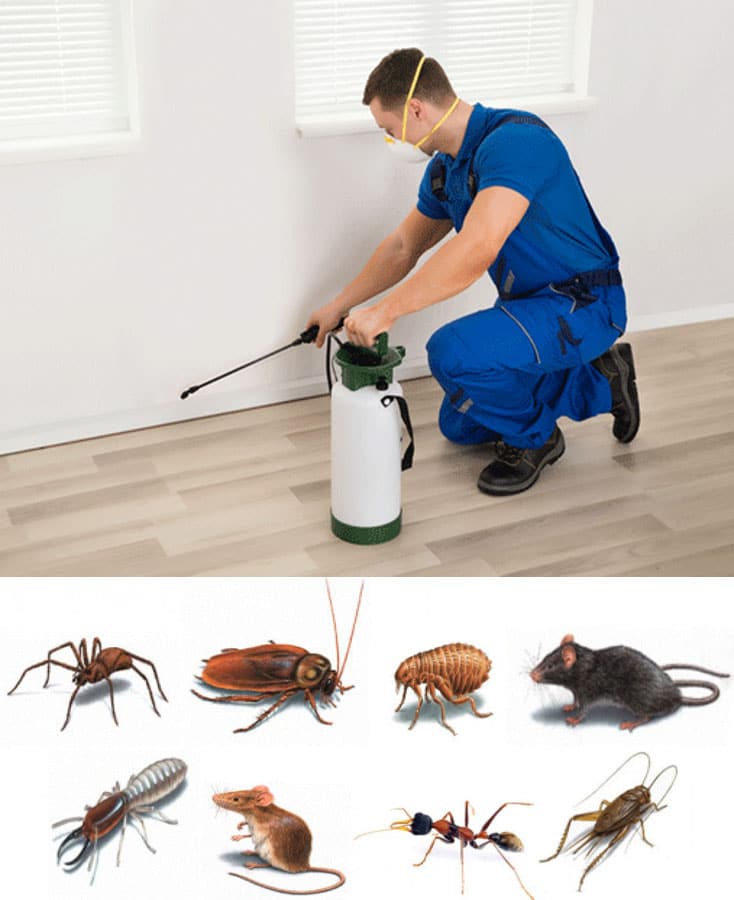Experienced A1 Exterminators Charlotte NC - Rapid and Trustworthy Solutions
Experienced A1 Exterminators Charlotte NC - Rapid and Trustworthy Solutions
Blog Article
Bed Pest Therapy Break Down: Contrasting Chemical Vs. Non-Chemical Solutions
In the world of pest control, specifically when taking care of the persistent concern of bed pests, the option between chemical and non-chemical treatment services can be an essential one. Both approaches use unique advantages and disadvantages, affecting elements such as performance, safety and security considerations, and general cost. By taking a look at the nuanced details of each approach, a more clear understanding of which course to seek in resolving a bed pest problem can be acquired.
Performance of Chemical Treatments
Chemical treatments for bed pest invasions have actually been commonly acknowledged for their potent and fast effectiveness in eliminating these bugs. When thinking about the efficiency of chemical therapies, it is essential to understand that they can provide a thorough and fast remedy to a bed insect problem.
In addition, chemical treatments have the benefit of using residual results, implying that they can remain to get rid of bed bugs also after the initial application. This recurring activity is especially advantageous in combating any kind of prospective re-infestations. In addition, the rapid action of chemical therapies can bring relief to individuals dealing with extreme bed insect problems, permitting them to reclaim control of their home promptly.
Safety Interest In Chemical Solutions
When utilizing chemical options for bed pest treatment is ensuring the safety of occupants and the atmosphere,One crucial aspect that requires mindful consideration. While chemical treatments can be efficient in eliminating bed insects, they may posture risks otherwise handled properly. Among the key safety and security worry about chemical remedies is the potential harm they can cause to human wellness. Direct exposure to specific chemicals utilized in bed pest treatments can lead to respiratory concerns, skin irritability, or other damaging responses, particularly in individuals with pre-existing problems or sensitivities. Furthermore, incorrect application or dosage of chemical pesticides can cause poisonous residues remaining in the cured location, positioning long-lasting wellness dangers to residents.
Moreover, the environmental influence of chemical remedies is an additional significant factor to consider. Some pesticides utilized in bed insect treatments may be hazardous to valuable bugs, wildlife, and ecosystems if they seep right into the dirt or water supply. It is vital to utilize chemical therapies judiciously, complying with security standards, and thinking about much less poisonous alternatives to mitigate these threats and ensure the risk-free and efficient management of bed bug invasions.
Advantages of Non-Chemical Strategies
Taking into consideration the potential security issues and environmental effect connected with chemical services for bed bug therapy, checking out non-chemical approaches offers an appealing alternative with numerous unique benefits. Non-chemical therapies are environmentally pleasant, as they do not contribute to air or water pollution, making them a lasting choice for parasite control.
Furthermore, non-chemical services can be reliable in targeting bed insects, including hard-to-reach areas where chemical therapies may not permeate. Approaches such as warmth therapy, vacuuming, vapor cleaning, and mattress coverings provide detailed elimination without the usage of dangerous chemicals. Additionally, non-chemical approaches can be less disruptive, calling for very little prep work and permitting quicker reentry into dealt with locations. Overall, selecting non-chemical bed pest therapy approaches not only prioritizes safety and environmental protection yet additionally guarantees effective and detailed parasite control.
Limitations of Non-Chemical Treatments

Furthermore, non-chemical treatments often need several applications to achieve effective elimination. This can be time-consuming and may not constantly assure full removal of all bed bugs and their eggs, particularly in hidden or hard-to-reach locations.
Moreover, the success of non-chemical therapies greatly depends on correct implementation and thoroughness, which can be testing for individuals without professional competence. Poor application of non-chemical techniques may lead to insufficient removal, bring about consistent problems and the requirement for additional therapies.
Therefore, while non-chemical therapies have their advantages, it is important to recognize these limitations and consider them when identifying the most effective technique for managing bed bug more helpful hints problems.
Cost Contrast: Chemical Vs. Non-Chemical Options
Provided the restrictions connected with non-chemical treatments, a necessary element to assess in the context of bed pest monitoring is the price contrast between chemical and non-chemical options. Chemical treatments normally entail the application of pesticides by experts, which can vary from $250 to $900 per space, depending upon the seriousness of the invasion and the dimension of the area to be treated. On the other hand, non-chemical treatments like heat treatment or vapor can be much more costly, with expenses ranging from $1,000 to $6,000 for an entire home. While the first expense of chemical treatments may appear reduced, several treatments might be needed to fully eradicate the problem, possibly boosting the general cost. On the various other hand, non-chemical alternatives might give click an extra sustainable and eco-friendly remedy, although they can be cost-prohibitive for some people. Ultimately, when considering the expense of bed insect therapy alternatives, it is necessary to evaluate the in advance expenditures against the efficiency and lasting sustainability of the picked approach.
Final Thought

Thinking about the possible security concerns and ecological influence associated with chemical solutions for bed bug therapy, discovering non-chemical methods provides an encouraging alternative with a number of unique advantages.Given the restrictions connected with non-chemical therapies, a necessary aspect to examine in the context of bed pest management is the cost comparison in between chemical and non-chemical options. In comparison, non-chemical therapies like warm treatment or heavy steam can be much more pricey, with expenses varying from $1,000 to $6,000 for an entire home. While the preliminary expense of chemical treatments may appear lower, multiple treatments may be needed to totally eliminate the invasion, potentially raising the general cost.In conclusion, when contrasting chemical and non-chemical bed click for info insect therapy choices, it is necessary to think about effectiveness, security, benefits, constraints, and expense.
Report this page